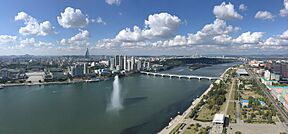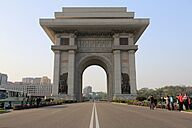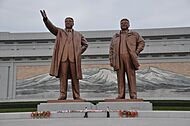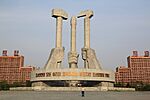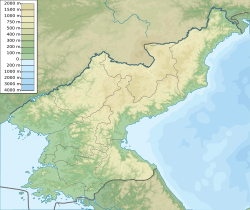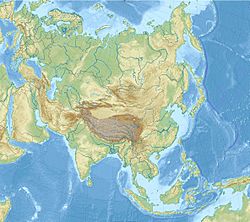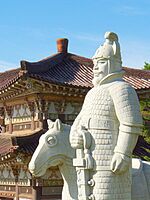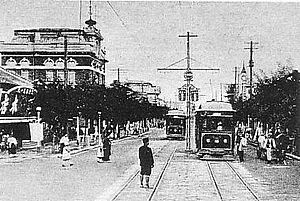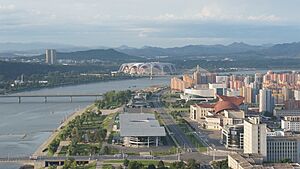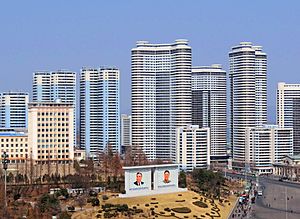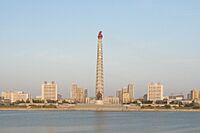Pyongyang facts for kids
Quick facts for kids
Pyongyang
평양시
|
|
|---|---|
|
Directly governed city
|
|
| Pyongyang Directly Governed City | |
| transcription(s) | |
| • Chosŏn'gŭl | 평양직할시 |
| • Hancha | 平壤直轄市 |
| • McCune–Reischauer | P'yŏngyang Chikhalsi |
| • Revised Romanization | Pyeongyang Jikhalsi |
|
Pyongyang skyline and the Taedong River
Arch of Triumph
Tomb of King Tongmyong
Monument to Party Founding
|
|
| Nickname(s):
(류경/柳京) (Korean)
"Capital of Willows" |
|
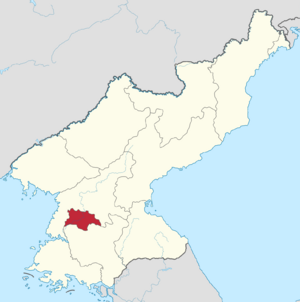
Pyongyang highlighted in red in North Korea
|
|
| Country | Democratic People's Republic of Korea |
| Districts |
19 districts(or wards), 2 counties,1 neighbourhood
Chung-guyok
Pyongchon-guyok Potonggang-guyok Moranbong-guyok Sosong-guyok Songyo-guyok Tongdaewon-guyok Taedonggang-guyok Sadong-guyok Taesong-guyok Mangyongdae-guyok Hyongjesan-guyok Ryongsong-guyok Samsok-guyok Ryokpo-guyok Rangrang-guyok Sunan-guyok Unjong-guyok Hwasong-guyok Kangdong County Kangnam County Panghyon-dong |
| Government | |
| • Type | Directly governed city |
| • Body | Pyongyang City People's Assembly |
| Area | |
| • Directly governed city | 829.1 km2 (320.1 sq mi) |
| • Metro | 3,194 km2 (1,233 sq mi) |
| Population
(2021)
|
|
| • Directly governed city | 3,157,538 |
| • Density | 3,808.39/km2 (9,863.7/sq mi) |
| Demonym(s) | Pyongyangite(s) |
| Time zone | UTC+09:00 (Pyongyang Time) |
| • Summer (DST) | (Not Observed) |
| ISO 3166 code | KP-01 |
| Pyongyang | |

"Pyongyang" in Chosŏn'gŭl (top) and hancha (bottom)
|
|
| Korean name | |
|---|---|
| Chosŏn'gŭl | |
| Hancha | |
| Revised Romanization | Pyeongyang |
| McCune–Reischauer | P'yŏngyang |
| lit. flat soil | |
Pyongyang (English: ![]() i/pjɒŋˈjæŋ, pjʌŋ-, -jɑːŋ/; Korean: [pʰjʌŋjaŋ]) is the capital and largest city of North Korea, officially called the Democratic People's Republic of Korea (DPRK). It is sometimes known as the "Capital of the Revolution."
i/pjɒŋˈjæŋ, pjʌŋ-, -jɑːŋ/; Korean: [pʰjʌŋjaŋ]) is the capital and largest city of North Korea, officially called the Democratic People's Republic of Korea (DPRK). It is sometimes known as the "Capital of the Revolution."
Pyongyang is located on the Taedong River, about 109 kilometers (68 miles) upstream from where it meets the Yellow Sea. In 2008, the city had a population of over 3.2 million people. Pyongyang is a special city, meaning it has the same importance as a province in North Korea.
This city is one of the oldest in Korea. It was once the capital of ancient Korean kingdoms like Gojoseon and Goguryeo. It also served as a second capital for the Goryeo kingdom. After North Korea was formed in 1948, Pyongyang became its main capital. The city was heavily damaged during the Korean War but was quickly rebuilt with help from the Soviet Union.
Today, Pyongyang is North Korea's main center for politics, industry, and transportation. Most people living here are connected to the ruling Workers' Party of Korea (WPK). The city is home to North Korea's main government buildings and the WPK headquarters.
Contents
- Understanding the Name of Pyongyang
- A Look at Pyongyang's History
- Pyongyang's Location and Weather
- How Pyongyang is Organized
- Pyongyang's Cityscape and Design
- Pyongyang's Culture and Lifestyle
- Sports in Pyongyang
- Pyongyang's Economy
- Education and Science in Pyongyang
- Sister Cities Around the World
- See also
Understanding the Name of Pyongyang
The name "Pyongyang" comes from the Korean words meaning "flat land." This name describes the city's geography, which is mostly flat.
Historically, the city had other names like Ryugyong, which means "Capital of Willows." In the early 1900s, missionaries called Pyongyang the "Jerusalem of the East." This was because it became a strong center for Christianity, especially Protestantism, after a religious revival in 1907.
A Look at Pyongyang's History
Early Beginnings and Ancient Kingdoms
Archaeologists found signs of very old villages in the Pyongyang area from thousands of years ago. North Koreans connect Pyongyang to the legendary city of "Asadal" or Wanggeom-seong. This city was the first capital of Gojoseon, an ancient Korean kingdom.
Pyongyang was founded in 1122 BC. It became the capital of Gojoseon from 194 to 108 BC. Later, the area was controlled by the Han dynasty of China. In 427 AD, the powerful kingdom of Goguryeo made Pyongyang its capital.
Wars and Changes Over Time
In 668 AD, the Chinese Tang dynasty took control of Pyongyang. However, the Korean kingdom of Silla soon took it back. For a while, Pyongyang was left empty. Later, during the Goryeo kingdom, it was rebuilt and became the "Western Capital."
During the Imjin War in the late 1500s, Japanese forces captured Pyongyang but were later defeated. In the 1600s, it was briefly occupied during the Qing invasion of Joseon. Despite these invasions, Christianity began to grow in Pyongyang. By 1880, it had many churches and was known as the "Jerusalem of the East."
In 1890, Pyongyang had 40,000 people. It was a key site during the First Sino-Japanese War in 1894, which caused much destruction. Under Japanese rule in Korea, Japan tried to make Pyongyang an industrial city. However, people resisted this rule.
By 1938, Pyongyang's population grew to 235,000.
Pyongyang After 1945
After World War II in 1945, Soviet forces entered Pyongyang. It became the temporary capital of North Korea. When North Korea was officially formed in 1948, Pyongyang became its permanent capital.
During the Korean War (1950-1953), Pyongyang was severely damaged by bombing. It was briefly occupied by South Korean forces. After the war ended in 1953, plans were immediately made to rebuild the city. With help from the Soviet Union, Pyongyang was quickly reconstructed. Many new buildings were built in a style similar to Soviet architecture.
In 1972, North Korea's constitution officially declared Pyongyang the capital.
In the 2000s, Pyongyang began a long-term plan to modernize. Many new homes and buildings were constructed, especially under the leadership of Kim Jong Un. These projects included new residential areas for scientists and large apartment complexes. Important public buildings like the Munsu Water Park and the renovated Pyongyang Sunan International Airport were also completed.
In 2024, a large housing project with 10,000 apartments was finished in the Hwasong area. Pyongyang also tried to host the 2032 Summer Olympics with Seoul, but their bid was not chosen.
Pyongyang's Location and Weather
Pyongyang is located in the west-central part of North Korea. It sits on a flat plain about 50 kilometers (31 miles) east of the Korea Bay, which is part of the Yellow Sea. The Taedong River flows through the city. The flat area where Pyongyang is located is one of the largest plains on Korea's western coast.
Pyongyang's Climate
Pyongyang has a climate with hot, humid summers and cold, dry winters. In winter, cold winds from Siberia make it very chilly. Temperatures are usually below freezing from November to early March. Snow falls for about 37 days each winter.
Summers are hot and humid, with the East Asian monsoon bringing a lot of rain from June to September. These are the hottest months, with average temperatures between 21 to 25 °C (70 to 77 °F). Daytime highs often go above 30 °C (86 °F). Spring and autumn have more pleasant weather, with clear, sunny skies.
| Climate data for Pyongyang (1991–2020 normals, extremes 1961–present) | |||||||||||||
|---|---|---|---|---|---|---|---|---|---|---|---|---|---|
| Month | Jan | Feb | Mar | Apr | May | Jun | Jul | Aug | Sep | Oct | Nov | Dec | Year |
| Record high °C (°F) | 12.0 (53.6) |
17.3 (63.1) |
22.4 (72.3) |
29.1 (84.4) |
34.0 (93.2) |
35.8 (96.4) |
36.9 (98.4) |
37.9 (100.2) |
33.5 (92.3) |
30.0 (86.0) |
26.0 (78.8) |
15.0 (59.0) |
37.9 (100.2) |
| Mean daily maximum °C (°F) | −0.4 (31.3) |
3.1 (37.6) |
9.7 (49.5) |
17.6 (63.7) |
23.5 (74.3) |
27.5 (81.5) |
29.1 (84.4) |
29.6 (85.3) |
25.7 (78.3) |
18.8 (65.8) |
9.7 (49.5) |
1.4 (34.5) |
16.3 (61.3) |
| Daily mean °C (°F) | −5.4 (22.3) |
−2.0 (28.4) |
4.0 (39.2) |
11.4 (52.5) |
17.4 (63.3) |
21.9 (71.4) |
24.7 (76.5) |
25.0 (77.0) |
20.2 (68.4) |
12.9 (55.2) |
4.8 (40.6) |
−2.9 (26.8) |
11.0 (51.8) |
| Mean daily minimum °C (°F) | −9.8 (14.4) |
−6.6 (20.1) |
−0.9 (30.4) |
5.9 (42.6) |
12.0 (53.6) |
17.4 (63.3) |
21.4 (70.5) |
21.5 (70.7) |
15.6 (60.1) |
7.8 (46.0) |
0.5 (32.9) |
−6.8 (19.8) |
6.5 (43.7) |
| Record low °C (°F) | −26.5 (−15.7) |
−23.4 (−10.1) |
−16.1 (3.0) |
−6.1 (21.0) |
2.2 (36.0) |
7.0 (44.6) |
11.1 (52.0) |
12.0 (53.6) |
3.6 (38.5) |
−6.0 (21.2) |
−14.0 (6.8) |
−22.8 (−9.0) |
−26.5 (−15.7) |
| Average precipitation mm (inches) | 9.6 (0.38) |
14.5 (0.57) |
23.9 (0.94) |
44.8 (1.76) |
74.7 (2.94) |
90.2 (3.55) |
274.7 (10.81) |
209.6 (8.25) |
90.8 (3.57) |
47.2 (1.86) |
38.4 (1.51) |
18.0 (0.71) |
936.4 (36.87) |
| Average precipitation days (≥ 0.1 mm) | 3.9 | 3.7 | 4.2 | 5.8 | 7.1 | 7.9 | 12.5 | 10.1 | 6.3 | 5.8 | 7.1 | 5.7 | 80.1 |
| Average snowy days | 5.4 | 4.0 | 1.8 | 0.3 | 0.0 | 0.0 | 0.0 | 0.0 | 0.0 | 0.1 | 1.9 | 5.5 | 19.0 |
| Average relative humidity (%) | 69.1 | 65.0 | 62.5 | 60.4 | 65.3 | 72.2 | 81.1 | 80.6 | 75.3 | 72.0 | 72.2 | 70.6 | 70.5 |
| Mean monthly sunshine hours | 184 | 197 | 231 | 237 | 263 | 229 | 181 | 204 | 222 | 214 | 165 | 165 | 2,492 |
| Average ultraviolet index | 2 | 3 | 4 | 6 | 7 | 8 | 9 | 9 | 7 | 4 | 2 | 1 | 5 |
| Source 1: Korea Meteorological Administration | |||||||||||||
| Source 2: Pogodaiklimat.ru (extremes), Deutscher Wetterdienst (sun, 1961–1990) and Weather Atlas | |||||||||||||
How Pyongyang is Organized
Pyongyang is divided into 19 wards (called guyŏk), 2 counties (called kun), and 1 neighborhood (called dong).
- Chung-guyok
- Pyongchon-guyok
- Potonggang-guyok
- Moranbong-guyok
- Sŏsŏng-guyŏk
- Songyo-guyok
- Tongdaewŏn-guyŏk
- Taedonggang-guyŏk
- Sadong-guyŏk
- Taesong-guyok
- Mangyongdae-guyok
- Hyongjesan-guyok
- Hwasong-guyok
- Ryongsong-guyok
- Samsok-guyok
- Ryokpo-guyok
- Rakrang-guyok
- Sunan-guyŏk
- Unjong-guyok
- Kangdong County
- Kangnam County
- Panghyŏn-dong
Some areas have been moved between Pyongyang and neighboring provinces over time. For example, Kangnam County was moved to North Hwanghae province in 2010 but returned to Pyongyang in 2011.
Pyongyang's Cityscape and Design
After being destroyed in the Korean War, Pyongyang was completely rebuilt. The goal was to create a capital that would inspire people after the war. The city now has wide, tree-lined streets and public buildings with beautiful designs. Its architecture is often compared to Soviet-style buildings.
The city's streets are laid out in a grid, making it look very organized. Pyongyang is designed with self-sufficient neighborhoods. Each neighborhood has its own shops, barbers, tailors, post office, clinic, and library. Many residents live in tall apartment buildings. The city's leaders wanted to control the population, so it is often quiet and not crowded.
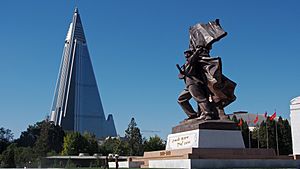
Pyongyang has three main types of buildings: monuments, buildings with traditional Korean designs, and tall high-rises. Famous monuments include the Juche Tower, the Arch of Triumph, and the Mansu Hill Grand Monument. The Juche Tower is a 170-meter (558-foot) tall granite tower that represents the Juche (self-reliance) idea. It has 25,550 granite blocks, one for each day of Kim Il Sung's life up to when it was built.
The most noticeable building in Pyongyang's skyline is the Ryugyong Hotel. It is one of the tallest hotels in the world, but it has not yet opened. Pyongyang's skyline is always changing, with many new high-rise apartment buildings being built.
Famous Landmarks to See
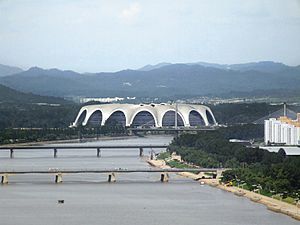
Some of the most famous places in Pyongyang include:
- The Ryugyong Hotel
- The Kumsusan Palace of the Sun
- The Arch of Triumph, which is bigger than the one in Paris
- The birthplace of Kim Il Sung at Mangyongdae Hill
- The Juche Tower
- Two large stadiums: the Rungrado 1st of May Stadium and the Kim Il-sung Stadium
- The Mansu Hill Grand Monument complex, which includes the Korean Revolution Museum
- Kim Il-sung Square
- The Yanggakdo International Hotel
The Pyongyang TV Tower is also a well-known sight. Other places to visit include the Korea Central Zoo. The Reunification Highway starts in Pyongyang and goes all the way to the Korean Demilitarized Zone (DMZ).
- Monuments and sights of Pyongyang
-
Juche Tower Monument to the philosophy of Juche (self-reliance)
Pyongyang's Culture and Lifestyle
Delicious Pyongyang Cuisine
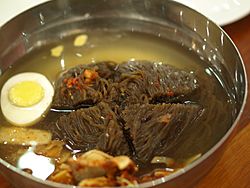
Pyongyang's food traditions are part of the larger Pyongan province cuisine. The most famous local dish is Pyongyang raengmyŏn, or "cold noodles." This dish has thin buckwheat noodles in a cold meat broth, often with dongchimi (watery kimchi) and a slice of sweet Korean pear.
Another special Pyongyang dish is Taedonggang sungeoguk, which means "flathead grey mullet soup from the Taedong River." This soup is made with flathead grey mullet fish, which are common in the Taedong River. It is traditionally served to guests visiting Pyongyang.
Pyongyang onban is another local favorite. It's "warm rice of Pyongyang," topped with sliced mushrooms, chicken, and bindaetteok (mung bean pancakes).
Social Life and Fun in the City
In recent years, Pyongyang has seen many new restaurants serving Korean and international food. Famous places include Okryu-gwan. You can also find street food vendors. Foreign foods like hamburgers, fries, pizza, and coffee are available. The city also has an active nightlife with late-night restaurants and karaoke.
For fun, Pyongyang offers water parks, amusement parks, skating rinks, health clubs, a shooting range, and even a dolphinarium.
Sports in Pyongyang
Pyongyang is home to several sports clubs. These include the April 25 Sports Club and the Pyongyang City Sports Club.
Pyongyang's Economy
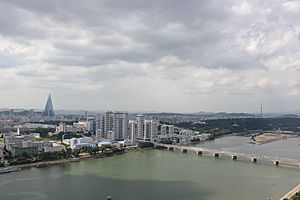
Pyongyang is North Korea's main industrial hub. It has many natural resources like coal, iron, and limestone. It also has good transport systems. Both light industries (like textiles and food) and heavy industries (like cement and machinery) are important here. The city also focuses on growing fresh produce and raising livestock like pigs and chickens to be self-sufficient in food.
Pyongyang used to have frequent power shortages. To fix this, new power stations were built to supply electricity directly to the city. More power projects are planned to increase the city's energy supply.
Shopping in Pyongyang
Pyongyang has several large department stores. These include the Pothonggang Department Store, Pyongyang Department Store No. 1, and Kwangbok Department Store.
There are also state-owned convenience stores called Hwanggumbol Shops. These shops offer goods at lower prices than private markets. They are designed to help the government control the economy.
Getting Around Pyongyang
Pyongyang is the main transport center for North Korea. It has a network of roads, railways, and air routes connecting it to other cities and countries. Major highways start here, going to Nampo, Wonsan, and Kaesong.
The Pyongyang railway station is a key hub for train travel. You can take international trains from Pyongyang to Beijing, the Chinese border city of Dandong, and even Moscow. A train trip to Beijing takes about 25 hours.
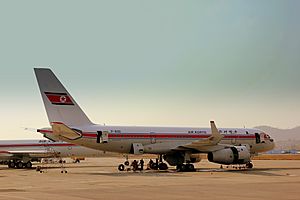
Within the city, people mainly use the subway, trams, and trolleybuses. Cycle lanes were added in 2015. There are not many cars in the city, as they are a symbol of status and hard to get. However, by 2018, Pyongyang started to experience some traffic jams.
Air Koryo, the state-owned airline, has international flights from Pyongyang Sunan International Airport to cities like Beijing, Shenyang, and Vladivostok. There are also domestic flights to other North Korean cities.
Education and Science in Pyongyang
Kim Il Sung University, North Korea's oldest university, was founded in 1946. It has many different departments, including medicine, physics, and law. The university also has its own publishing house, sports club, museums, and libraries.
Other important universities include Kim Chaek University of Technology, Pyongyang University of Music and Dance, and Pyongyang University of Foreign Studies. Pyongyang University of Science and Technology (PUST) is the country's first private university, where most teachers are American and classes are taught in English.
Pyongyang also has a science and technology hall being built. Its goal is to gather teaching materials and research data in digital form for the whole country. The city also has a special machine called a cyclotron, used for student training and making medical isotopes.
Sister Cities Around the World
Pyongyang is connected with other cities around the world as "sister cities." These connections help promote cultural exchange and friendship.
 Baghdad, Iraq
Baghdad, Iraq Chiang Mai, Thailand
Chiang Mai, Thailand Dubai, United Arab Emirates
Dubai, United Arab Emirates Jakarta, Indonesia
Jakarta, Indonesia Kathmandu, Nepal
Kathmandu, Nepal Moscow, Russia
Moscow, Russia Tianjin, China
Tianjin, China Ulaanbaatar, Mongolia
Ulaanbaatar, Mongolia
See also
 In Spanish: Pionyang para niños
In Spanish: Pionyang para niños


